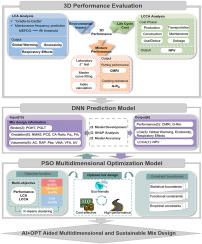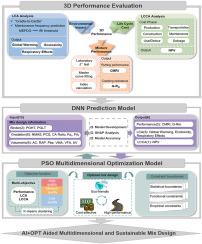考虑混合料性能、环境影响和生命周期成本的沥青混合料设计优化
IF 10
1区 环境科学与生态学
Q1 ENGINEERING, ENVIRONMENTAL
引用次数: 0
摘要
用于路面基础设施表层的高机械性能沥青混合料往往以增加环境影响和成本为代价,而环保替代品可能会损害其耐久性。优化混合料设计并在这些方面之间取得平衡对于生产更清洁的混合料和延长路面使用寿命至关重要。本研究提出了一个综合框架,将平衡混合料设计(BMD)、生命周期评估(LCA)和生命周期成本分析(LCCA)相结合,系统地评估和平衡沥青混合料性能、环境影响和成本的竞争目标。利用深度神经网络(DNN)捕捉混合料设计变量和关键指标之间的非线性相互作用,并结合粒子群算法(PSO)进行混合料组合的多目标优化。为了提高透明度并指导决策,应用Shapley加性解释(SHAP)分析来确定关键的可持续变量,如高温性能等级(PGHT)、再生沥青路面(RAP)含量和级配参数,这些参数对路面性能和生命周期结果有显著影响。优化后的设计显示出更好的车辙和抗裂性,同时显著降低了全球变暖潜势、呼吸效应、生态毒性和生命周期成本。该框架有效地将实验室研究与实际实施联系起来,为设计耐用、成本效益高、环境可持续的沥青路面提供了一种全面、可扩展的方法,并有助于人工智能和优化辅助的多维可持续混合设计的进步。本文章由计算机程序翻译,如有差异,请以英文原文为准。


Optimization of asphalt mix design considering mixture performance, environmental impact, and life cycle cost
High mechanical performance of asphalt mixture used in the surface layers of pavement infrastructure often comes at the expense of increased environmental impact and cost, while eco-friendly alternatives may compromise its durability. Optimizing the mix design and achieving the trade-off between these aspects are critical for cleaner mixture production and longer-performing pavement. This study proposes an integrated framework that combines Balanced Mix Design (BMD), Life Cycle Assessment (LCA), and Life Cycle Cost Analysis (LCCA) to systematically evaluate and balance the competing objectives of asphalt mixture performance, environmental impact, and cost. A deep neural network (DNN) was developed to capture the nonlinear interactions among mix design variables and key indicators, and was coupled with Particle Swarm Optimization (PSO) for multi-objective optimization of mix combinations. To enhance transparency and guide decision-making, Shapley Additive Explanations (SHAP) analysis was applied to identify critical sustainable variables—such as high-temperature performance grade (PGHT), recycled asphalt pavement (RAP) content, and gradation parameters—that significantly affect pavement performance and life-cycle outcomes. The optimized designs demonstrated improved rutting and cracking resistance, while significantly reducing global warming potential, respiratory effect, ecotoxicity, and life-cycle costs. This framework effectively bridges laboratory research with practical implementation, offering a comprehensive and scalable approach to designing durable, cost-effective, and environmentally sustainable asphalt pavements, and contributing to the advancement of AI- and optimization-aided multidimensional and sustainable mix design.
求助全文
通过发布文献求助,成功后即可免费获取论文全文。
去求助
来源期刊

Journal of Cleaner Production
环境科学-工程:环境
CiteScore
20.40
自引率
9.00%
发文量
4720
审稿时长
111 days
期刊介绍:
The Journal of Cleaner Production is an international, transdisciplinary journal that addresses and discusses theoretical and practical Cleaner Production, Environmental, and Sustainability issues. It aims to help societies become more sustainable by focusing on the concept of 'Cleaner Production', which aims at preventing waste production and increasing efficiencies in energy, water, resources, and human capital use. The journal serves as a platform for corporations, governments, education institutions, regions, and societies to engage in discussions and research related to Cleaner Production, environmental, and sustainability practices.
 求助内容:
求助内容: 应助结果提醒方式:
应助结果提醒方式:


